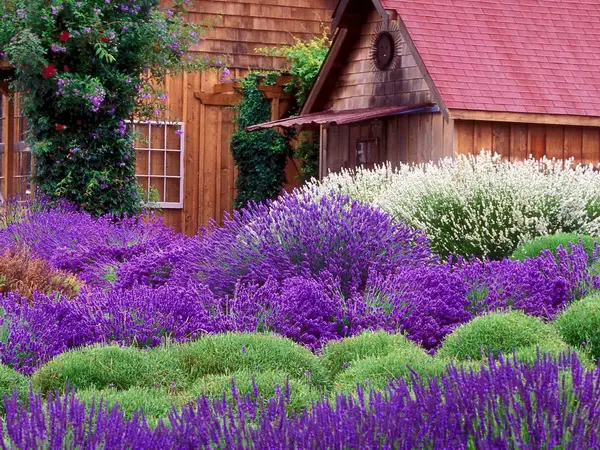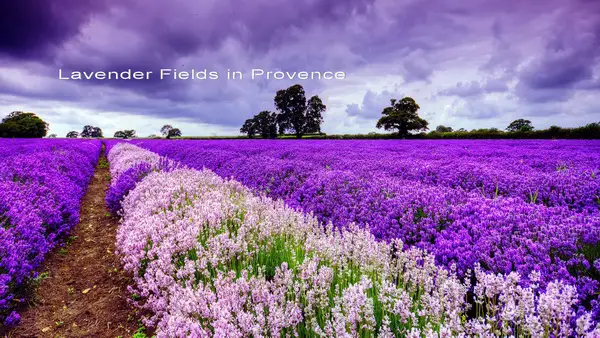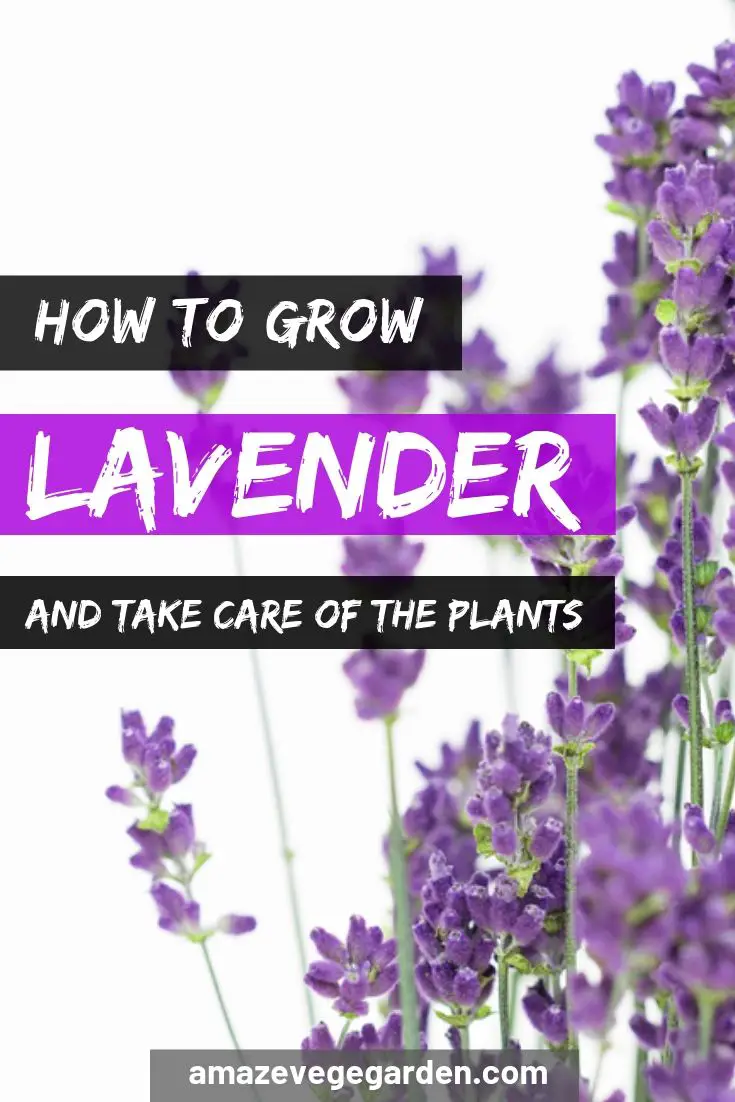The great thing about growing lavender is its high drought tolerance and low maintenance demands.
Add to that lavender’s beautiful perfume, color, and health benefits (from its oil), and you have a near-perfect garden plant – for ornamental purposes or as a beneficial culinary and medical plant.
There are about 35 officially recorded species of lavender with hundreds of recognized cultivars, varieties, and forms.
How To Grow Healthy Lavender
- Position plants in full sun for best results.
- Grow in free-draining soil that will drain in winter – lavenders do not like wet feet!
- Prune regularly – especially after flowering. This will keep the plants neat and bushy. If you neglect this, they will get leggy – and then, if you prune into the woody bits, they won’t regenerate!
- Lavenders tolerate well dry, windy, and harsh spots. However, your nursery can also tell you about humidity-tolerant varieties.
Growing Lavender in Your Herb Garden
Start growing lavender alongside your garden paths or on your patio to enjoy the magnificent and unforgettable fragrance of these plants as you brush the leaves when you walk past. You will indulge yourself with the unforgettable smell of fresh lavender.
Lavender isn’t a difficult plant to grow. It’s versatile and resilient and will flourish all summer long without needing lots of care and attention. It’s one of the most popular garden plants, but people often forget it’s an herb.
Most of us are familiar with lavender because of its beautiful smell, but it also has many remarkable medicinal properties like other herbs.
We’ll describe how to grow lavender and discuss how you can easily use its medicinal properties.
In the past, lavender cuttings used to be burnt or strewn across the floor to improve the smell of rooms. Nowadays, we are more likely to use lavender aerosol spray for this purpose. But whilst using a lavender aerosol spray is more convenient, you can’t beat the strong aroma of natural lavender – as you’ll find out when you start growing lavender in your own garden.
Lavender Varieties
There are hundreds of varieties of lavender, but it’s important to choose the lavender variety that will grow in your garden because not all of them are equally hardy.
Lavender Growing Wild in France
If you live in a Mediterranean-style climate, you’ll be able to use a lavender variety called Lavendula Stoechas (French lavender). This variety is centuries old and grows wild in France and Spain.
If you’re fortunate enough to visit certain areas of France when the lavender is in season (such as the Iles d’ Hyeres near the French Riviera), the fields of wild lavender, you’ll find there present a wonderful spectacle.
However, if you live in an area with cold winters, you should choose a variety of lavender called Lavendula Augustifolia (e.g., the Hidcote variety, which has deep purple flowers and silver-grey foliage).
But if you are just about to start growing lavender, don’t worry too much about researching varieties. Buy your lavender plants from a local gardening outlet, and they’ll recommend the variety of lavender you should grow, whether for plant borders or a lavender hedge.
For those of us that don’t enjoy a Mediterranean climate, the varieties that you’re likely to choose are amongst the following:
- Folgate — an early flowering variety that has a vibrant color and produces a very high-quality lavender oil.
- Imperial Gem — a neat, compact variety with a deep blue color. It’s ideal for cutting and bunching.
- Maillette — this is the “queen” of the Angustifolia lavenders. It’s very highly scented and produces high-quality lavender oil.
- Grosso — a variety that produces a high-quality lavender oil rich in camphor.
- And of course, one of the most popular – Hidcote.
Some Recommended Varieties
- English Lavender (Lavandula Angustifolia) – which is really French! The one that produces the best oil and potpourri.
- Lavandin (Lavandula x intermedia) – this is a natural cross between L Angustifolia and Latifolia. Slightly more camphor than English Lavender, it produces easily extracted oil and is commonly used as an essential oil and perfumes.
- French Lavender (Lavandula Dentata) – has toothed grey leaves and winter to spring flowering. Ideal for coastal areas as it tolerates humid conditions. Largest of the lavenders, it makes for a great ornamental hedge.
- Italian Lavender (Lavandula Stoechas). Recognized by the little “wings” on the top of the flower spikes, the oil has high camphor and a pungent pine-like smell – and is used in insect and moth repellents. They seed easily – so in some areas may be classed as a problem plant.
How to Plant Your Lavender
The factors that will affect the success of your lavender plants are soil, position, planting, and spacing.
Each of these is discussed in the following paragraphs.
To start growing lavender, your soil must be well-drained, slightly gravelly, and slightly limey or chalky. Plant your lavender plants in the early spring.
Position them twelve inches apart for a border or up to 24 inches apart if you have bought your lavender plants to grow a lavender hedge.
Check with your local gardening outlet on planting distances, though, because some lavenders grow much taller than others and will need more space between plants.
Make a hole for each lavender plant that is about twice as large as and a little deeper than the size of your lavender pot. Dig in some fine gravel and a small amount (half an egg cup) of lime, and then pour a small bucket of water into the hole.
Position your lavender in the hole and fill in around the plant with the soil you removed to create the hole. Firm the soil around the plant and make sure the surface is level (so that water doesn’t collect in the depression when it rains.
Where to Plant your Lavender
Lavenders love the sun – they won’t flower well in the shade. Bearing this in mind, try and plant your lavender facing south in a sunny position. If there’s too much shade, your lavender plant won’t flower.
Growing Lavender in Containers
If you don’t have a garden or want to grow lavender on your patio, you can grow it in container pots or hanging baskets. Don’t use shop-bought compost for your container. Use garden soil (you can also buy a soil substitute at your gardening outlet) and add a broken pot or gravel pieces at the bottom to help with drainage.
If you want to grow French lavender, it will survive well on patios and balconies because they are generally protected from harsh weather. Also, if you grow your lavender in pots, you can move the pots to more sheltered positions during the winter to protect them from frost.
Looking After Your Lavender
When growing lavender, make sure you water your plants well after planting them. Once your lavender is well-established, it will withstand quite dry conditions. If you are growing lavender in containers, these will need to be watered more frequently during the summer months to keep the soil around the plants moist.
Feed your lavender once during the growing season using a little potash (or a similar lime-based nutrient) spread around the base of the plant. This will encourage the plants to flower with vibrant colors.
Hardy lavenders of the Lavendula Augustifolia variety should be cut down to the old wood in August after they’ve finished flowering. If you do this, the plant will heal before the frost sets in. If you are growing French lavender, you should prune it quite hard after the first batch of flowers (to a height of 9 inches). After this dead-head, the lavender frequently throughout the growing season.
If you follow the instructions above, your lavender plants should last 8 to 10 years.
Use of Lavender
When your lavender has grown and is producing its fantastic and memorable fragrance, you’ll be able to begin using it inside your home. Start by putting bowls of flowers around the home and put muslin bags of flowers and lavender leaves under your pillow at night to relieve stress and help you sleep.
Lavender oils are a trendy way of using lavender. Whilst it’s possible to prepare your own oils from lavender, it’s much easier to buy lavender oil. They aren’t expensive and can be used for massages, in baths, and steam inhalations. These oils are antibacterial and anti-fungal and are an excellent treatment for anxiety and stress-related conditions.
What Next?
Once you start growing lavender, you should investigate the other medicinal properties of this amazing plant. But you don’t need to go to great lengths to enjoy the benefits of lavender. Just use the leaves and flowers around your home as described above, and make the most of the smell of this wonderful plant both inside and out.
Did you find this post useful? Would you like to get back to it later? Save THIS PIN below to your gardening, flowers, or house plant board on Pinterest! Thanks 🙂



